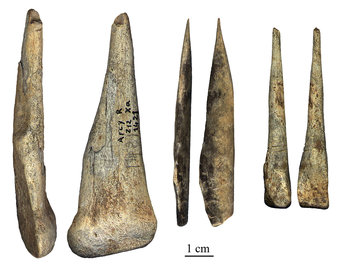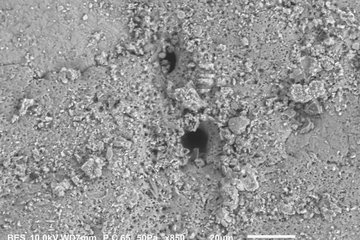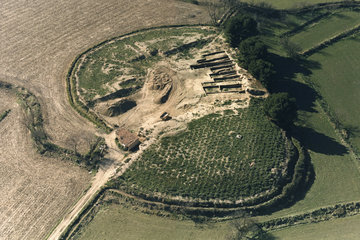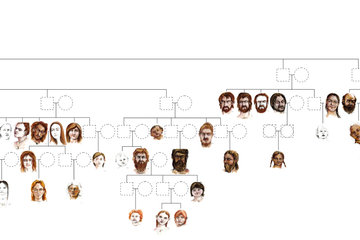Neanderthals meet Homo sapiens
New high precision radiocarbon dates of bone collagen show that a cultural exchange may have taken place between modern humans and Neanderthals more than 40,000 years ago.
It has long been debated whether the Châtelperronian (CP), a transitional industry from central and southwestern France and northern Spain, was manufactured by Neanderthals or modern humans. An international team of researchers led by Jean-Jacques Hublin of the Max Planck Institute for Evolutionary Anthropology in Leipzig, Germany, has now analyzed bone samples from two sites in France, Grotte du Renne and Saint Césaire, and radiocarbon-dated them using an accelerator mass spectrometer. The new high precision dates show that the CP bone tools and body ornaments were produced by Neanderthals. However since these late Neanderthals only manufactured CP body ornaments after modern humans arrived in neighboring regions, the study suggests that cultural diffusion might have taken place between modern humans and Neanderthals.

The so called “transitional industries” are a key for understanding the replacement process of Neanderthals by modern humans in western Eurasia at the beginning of the Upper Paleolithic between 50,000 and 40,000 years ago. While in Europe the older Mousterian industry of the Middle Paleolithic can be clearly attributed to Neanderthals and the later Upper Paleolithic assemblages to modern humans, the nature of the makers of the transitional Châtelperronian (CP) industry has long been disputed.
CP assemblages from the French sites Grotte du Renne and Saint Césaire have yielded well-identified Neanderthal remains. However at the Grotte du Renne, CP layers also produced rather sophisticated bone tools and body ornaments. Despite this fossil evidence the question of whether Neanderthals could manufacture such sophisticated objects is the topic of intense debate. “This results in part from the fact that the Châtelperronian documents the broadest spectrum of behavioral features reminiscent of the subsequent local Upper Paleolithic, which was undisputedly created by modern humans”, says Jean-Jacques Hublin of the Max Planck Institute for Evolutionary Anthropology who led the study. Some have proposed that the admixture of artifacts between different layers could explain this association.

Hublin’s research team selected 40 well-preserved bone samples from the Grotte du Renne, primarily from those areas that contained CP body ornaments or Neanderthal remains but also from the underlying older Mousterian and younger Protoaurignacian layers. In addition, a Neanderthal tibia bone from Saint Césaire was analyzed. The researchers extracted collagen from the samples and dated the bones by taking isotopic measurements. Using an accelerator mass spectrometer the researchers obtained very high precision 14C dates. “In Leipzig, scientists use the most advanced techniques for high precision radiocarbon (14C) dating of bones ”, says Jean-Jacques Hublin.
At the Grotte du Renne, the large series of dates obtained prove that no major layer admixture occurred in the site. The CP phase is dated to between 44,500 and 41,000 years ago and the CP Neanderthal skeleton of Saint-Césaire from the end of this time period ca. 41,500 years ago. This confirms that Neanderthal populations are directly responsible for the production of CP assemblages in central France, including the body ornaments of Arcy.
“These ages are significant for another reason as well, namely because modern humans replaced the last known European Neanderthals starting around 50,000 years ago and were already present in Southern France and in Germany when Neanderthals produced the CP”, says Jean-Jacques Hublin. “Given the dating results, we believe that Neanderthals made sophisticated bone tools and body ornaments only after modern humans introduced these new behaviors in Western Europe. Most likely, some level of cultural diffusion occurred from one group to the other more than 40,000 years ago.”













